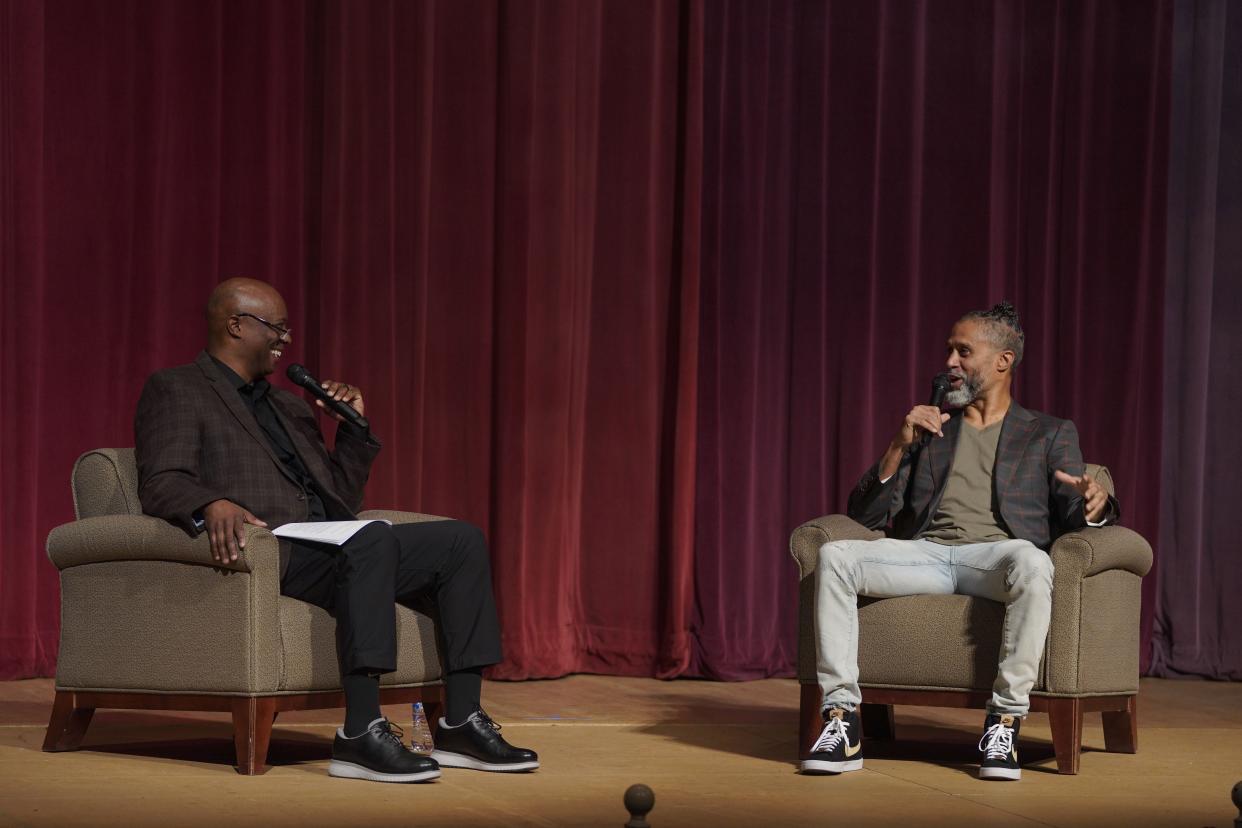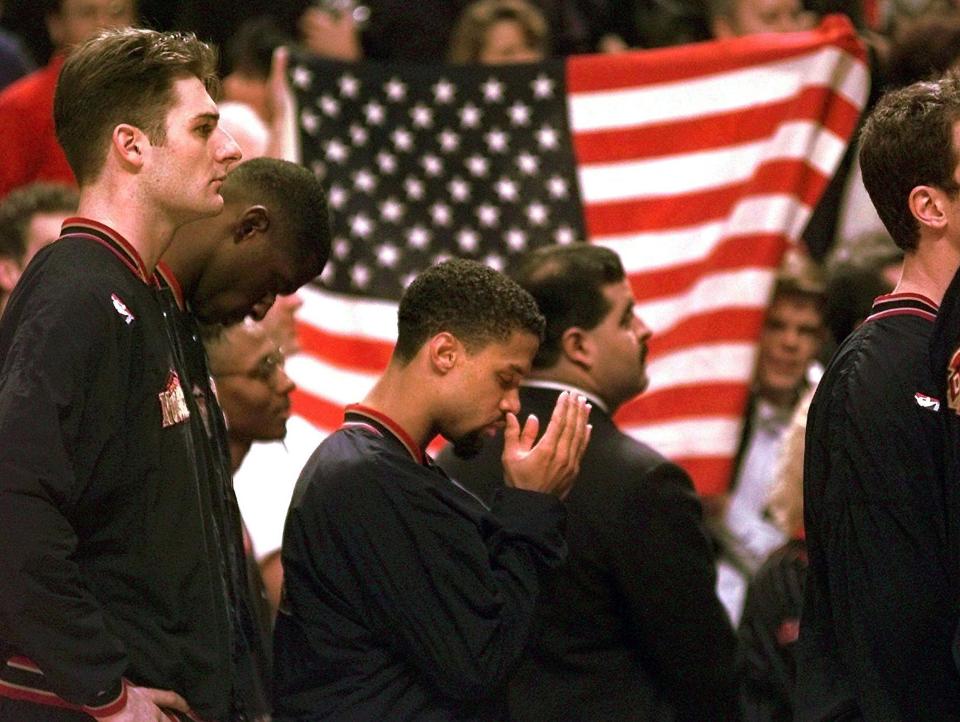What we learned from ex-NBA star Mahmoud Abdul-Rauf on his childhood, taking stand for beliefs

- Oops!Something went wrong.Please try again later.
- Oops!Something went wrong.Please try again later.
Mahmoud Abdul-Rauf, a former NBA star and social justice activist, visited the University of the Pacific on Tuesday as part of its Black History Month celebration this month.
In an interview that men's basketball head coach Leonard Perry conducted, Abdul-Rauf, 53, spoke about his life growing up in the South and his basketball career before and after he converted to Islam.
The Mississippi native was born Chris Jackson and was raised with two siblings by their single mother. They lived in poverty.
From an early age, Abdul-Rauf knew he had a gift. Living with Tourette syndrome didn’t make it any easier, but it did push him to become the best he could be, he said.
His promising career as a professional basketball player was cut short after nine years when his faith didn’t align with the rules the NBA had for players. He made headlines and received hate mail after he made the decision to not stand for the national anthem in 1996.
“You can’t be for God and the devil at the same time. You can’t be for justice and injustice at the same time. You have to take a position,” Abdul-Rauf said.
Here is what we learned about Abdul-Rauf's life living with Tourette syndrome, his decision to go to the NBA and his conversion to Islam.
1. Living with Tourette syndrome
Around the time he was a third- or fourth-grader, he started having blackouts.
“My tics would just intensify … whatever I'm doing with my right a lot of times I had to do with my left," Abdul-Rauf said. "And so this is like every single day just fighting, trying to navigate and negotiate with what your mind is telling you what your body wants to do."
Misdiagnosed by a doctor who told him he had “habits” that come and go, he believed it. Then in the 11th grade, his school's head coach suggested taking him to see a specialist.
That is when a doctor diagnosed him with Tourette syndrome.
“It's like a weight was just taken off my shoulders because there was a name. The name is very powerful,” he said.
Tourette’s brought many challenges for him, but it also made him a better player on the court.
He talked about how he would go to practice for two hours. When practice was over, he would stay to make 10 shots. But those 10 shots had to be perfect and could not touch the rim at all. If it did he would start over and over and over again until it didn’t.
“Every day I was flirting with death,” he said.
He said his Tourette's has not stopped but he has learned to camouflage tics.
2. Going pro
Abdul-Rauf knew he had a gift early on, but he didn’t know how much of a gift he had.
“For me, basketball was something that just came a little bit more natural,” he said.
He played for Louisiana State University during his freshman and sophomore years. As a freshman at LSU, he made the cover of Sports Illustrated.
He shared how his turning point came one day when he visited his mother's home.
He opened the refrigerator and it was empty. He went to the restroom to wash his hands. When he leaned on the sink, it collapsed on the floor. That was it.
After playing for two years at LSU, he told his LSU coach he wanted to play in the NBA.
“My mother is everything (to me)...I got to take care of her,” Abdul-Rauf emotionally said.
His coach's response surprised him. He told him it was the best decision he could make.
He knew if he went pro, he would be able to take care of his mother. So he did.
In 1990, Abdul-Rauf was the third overall pick of the Denver Nuggets during the NBA draft.
Abdul-Rauf converted to Islam when he was in the NBA, and he changed his name.
He played six years with the Denver Nuggets and was then traded to the Sacramento Kings. He later took a break from the NBA, and played in other leagues before returning for one last year with the Vancouver Grizzlies.
3. Embracing his faith
With many questions unanswered and unfulfilled with his Baptist Christian faith, he started searching for that missing piece in his life.
“If people looked at me they probably saw a confident individual on the court. But I had a lot of insecurities. I looked at myself as inadequate in many other areas of my life, especially educationally,” he said.
It was while he was at LSU, that head coach Dale Brown shared the autobiography of American Muslim minister and human rights activist Malcolm X with him.
As he read more and more about the Islamic faith, he started finding some of the answers he had been looking for, he said.
His views about America changed, and he found that his beliefs no longer aligned with what he observed. People he looked up to changed, he noticed.
To protest oppression, he refused to stand for the American national anthem.
It stirred controversy, and some say his stance was the blueprint for what would come 20 years later when 49ers quarterback Colin Kaepernick took a knee during the anthem to protest racial injustice.
Kaepernick kneeled at a preseason game against the Chargers for the first time on Sep. 1, 2016.
“It sounds cliche, but when I say I was so comfortable with my information, I was so comfortable with my faith and my position. I was so comfortable with my belief in God and how things are going," Abdul-Rauf said.
His faith was bigger than the game, he said.
This was not the first time he had chosen not to stand for the anthem, but it was the first time someone had noticed.
It cost him his home, which the Ku Klux Klan burned down, and his NBA career.

Earlier this month, “Stand” a Showtime documentary about his life premiered. The documentary features NBA star Stephen Curry, who Abdul-Rauf is often compared to, and former LSU teammate Shaquille O'Neal “Shaq.”
Abdul-Rauf recently released his autobiography, “In the Blink of an Eye,” published by Kaepernick Publishing.
He continues to step onto the court with the Big3 basketball league, which he co-captains, and does public speaking gigs about his life and social justice advocacy.
“We're human first, athletes second,” he said.
Record reporter Angelaydet Rocha covers community news in Stockton and San Joaquin County. She can be reached at arocha@recordnet.com or on Twitter @AngelaydetRocha. Support local news, subscribe to The Stockton Record at https://www.recordnet.com/subscribenow.
This article originally appeared on The Record: Ex-NBA star Mahmoud Abdul-Rauf on childhood, taking stand for beliefs

